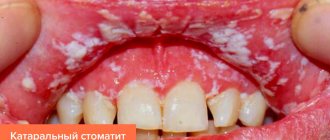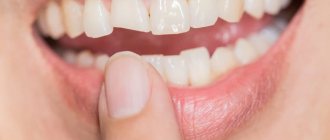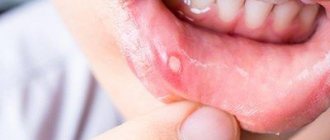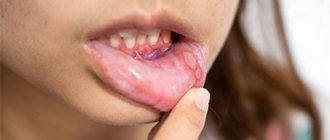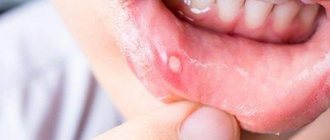| Type of stomatitis | Possible reasons | Features of the flow |
| Viral | Causative agents of herpes, measles, chickenpox, which are transmitted by airborne droplets and by contact with a carrier. | The patient's general condition is serious: the temperature rises above +380C, diarrhea, nausea and uncontrollable vomiting are possible. Bubbles filled with clear liquid appear on the mucous membrane of the mouth. Very quickly they burst, forming ulcers. But after 3-4 days they become crusty and heal on their own. The disease lasts 1-2 weeks. |
| Fungal | Candida fungus, the activity of which is provoked by decreased immunity, vitamin deficiency or hypothermia. | Fungal stomatitis most often affects children, the elderly and pregnant women. Recognizable by a white coating on the palate, tongue, and inner surface of the cheeks. Patients complain of pain while eating. |
| Aphthous (bacterial) | Decreased general and local immunity due to infection. Pathogens: staphylococci, streptococci, gonococci, mycobacteria. In women with chronic gastritis or gastric ulcer - Helicobacter pylori activity. | Aphthous stomatitis is dangerous due to its long course and high probability of relapses, which usually occur in spring and autumn. On the mucous membrane, aphthae are visible - round blisters surrounded by a scarlet border and covered with a grayish coating. They can be single or multiple, and sometimes merge into extensive lesions. |
| Catarrhal | Tartar, untreated caries, poor oral hygiene. | This is the same stomatitis of “dirty hands”. It occurs more often than other varieties, but it also occurs much more easily. You can recognize it by the pronounced soreness of the mucous membrane, its swelling and dryness. Bleeding of the cheeks, a yellowish coating on the tongue and the inner surface of the cheeks may be observed. Accompanied by an unpleasant odor from the mouth. |
| Allergic | Certain foods (often strawberries, citrus fruits), medications, oral care products, and even the materials from which crowns, veneers, fillings, and dentures are made can act as an allergen. | Allergic stomatitis is considered the most severe type of the disease. Patients complain of unbearable burning and pain even when trying to breathe air through their mouth. |
| Nicotinic | Long-term smoking | Hot smoke regularly irritates the soft and hard palates. At first, the tissues become denser, but for the patient this process is painless and therefore goes unnoticed. In the advanced stage, all soft tissues are covered with multiple ulcers. And doctors confidently call nicotine stomatitis a precancerous disease. |
Stomatitis and ulceration of the oral mucosa during pregnancy can be caused by sodium lauryl sulfate (SLS), an ingredient in most toothpastes. It is with its help that manufacturers achieve abundant foam formation. If this component is not directly indicated in the composition, you can find out about its presence by the innocuous phrase: “foaming agent obtained from coconuts.”
Do treatment methods for stomatitis depend on the timing of pregnancy?
First of all, we must keep in mind that the first, second and ninth months are the most undesirable in terms of any intervention. Therefore, it is better not to treat stomatitis during these periods. The methods depend on the form of the disease: candidal stomatitis is treated with antifungal drugs, viral - with antiviral drugs, bacterial - with antibiotics, and in the allergic form of stomatitis, contact with the allergen is excluded or antihistamines are prescribed. Whatever method is used, the dentist takes into account the patient’s condition and selects exclusively harmless means of therapy.
The dangers and consequences of stomatitis in pregnant women
Stomatitis is not a harmless disease at all! Developing against the background of reduced immunity, it further weakens the body with waste products of fungi, viruses or bacteria. And since the circulatory system of mother and fetus is still one, the danger is enormous! In the early stages, when all organs and systems are being formed, it is stomatitis that can cause a program failure, and the child will be born with a pathology.
Another danger is the transition of stomatitis to a chronic form, when the disease will subside only for a while, and after a few weeks it will reappear. Each time the course of the disease will become more and more severe: the simplest catarrhal variety will quickly turn into ulcerative stomatitis. Well, it’s not far from gangrene, which affects not only soft tissues, but also the bones of the jaw apparatus.
And even when treatment is started on time, you cannot relax! Difficulties in eating and drinking that are quite natural for stomatitis can lead to dehydration. And not only for the expectant mother herself, but also for her baby. Therefore, no matter how difficult it may be, you need to make sure that you drink at least 1.5 liters of water per day.
What should be the prevention of stomatitis during pregnancy?
The most important thing is to take good care of your oral cavity. Ask your dentist to recommend a suitable antibacterial toothpaste. Be sure to use mouthwash and dental floss. A healthy diet is also of great importance: balance your diet, do not get carried away with sweet carbohydrate foods (bacteria love them very much). Take vitamins - they will help support the body during the difficult period of bearing a baby.
Stomatitis during pregnancy: before and after photos
Experts' opinion
The effectiveness of ASEPTA rinses has been repeatedly proven by clinical studies. For example, according to A.K. Iordanishvili, Doctor of Medicine Sc., professor, North-Western State Medical University named after. I.I. Mechnikov, based on a study of 46 people suffering from gum inflammation, it was found that the use of mouth rinses “ASEPTA PARODONTAL ACTIVE” and “ASEPTA PARODONTAL FRESH” (JSC “VERTEX”, Russia) allows not only to improve oral hygiene and reduce inflammatory processes in the gums by 55.37%, but also reduce the number of relapses of localized periodontitis by 21.36%.
Sources:
- Prevention of recurrence of localized periodontitis in young A.K. YORDANISHVILI, Doctor of Medical Sciences, Professor, North-Western State Medical University named after. I.I. Mechnikov, Military Medical Academy named after. CM. Kirov, International Academy of Sciences of Ecology, Human Safety and Nature.
- Report on clinical trials to determine/confirm the preventive properties of commercially produced personal oral hygiene products: mouth rinse "ASEPTA PARODONTAL" - Solution for irrigator." Doctor of Medical Sciences Professor, Honored Doctor of the Russian Federation, Head. Department of Preventive Dentistry S.B. Ulitovsky, doctor-researcher A.A. Leontiev First St. Petersburg State Medical University named after academician I.P. Pavlova, Department of Preventive Dentistry.
- Report on determining/confirming the preventive properties of commercially produced personal oral hygiene products: Asepta toothpaste used in combination with Asepta mouthwash and Asepta gum balm Head. Department of PFS Doctor of Medical Sciences Professor S.B. Ulitovsky St. Petersburg State Medical University named after Academician I.P. Pavlova. Faculty of Dentistry. Department of Preventive Dentistry.
HRAS classification:
| CAUSES | A COMMENT | ||
| causes: | Clinically, several forms of HRAS are distinguished: | a comment: | 1) fibrinous form: the size of aphthae is 2-3 mm, heal in 6-8 days 2) small canker sores (Mikulich’s aphthae): the size of aphthae is up to 1 cm, heal in 10-14 days 3) large Setton’s aphthae: the size of aphthae is from 1 to 3 cm, heal for a very long time, up to several months, leaving scars 4) herpetiform type: the smallest aphthae that merge |
| causes: | HRAS as a symptom of the disease: | a comment: | 1) Behcet's disease 2) Reiter's disease |
| causes: | According to severity, HRAS is divided into: | a comment: | 1) mild form: 1-2 aphthae, once every 2 years 2) moderate form: 3-6 aphthae, relapse 2 times a year 3) severe form: more than 6 aphthae, relapse several times a year |
Literature:
- Aphthous stomatitis. Nurse, No. 5, 2015, p. 21.
- Mikhalchenko V.F., Firsova I.V., Fedotova Yu.M. and others. A new approach to the treatment of chronic recurrent aphthous stomatitis (Setton's aphthosis) using the method of photoactivated disinfection and the immunomodulator Galavit. Modern problems of science and education. No. 6, 2015, pp. 1-6.
- Salomão Israel Monteiro Lourenço Queiroz, Marcus Vinícius Amarante da Silva. Ana Miryam Costa de Medeiros. Recurrent aphthous ulceration: an epidemiological study of etiological factors, treatment and differential diagnosis. (Recurrent aphthous ulcers: epidemiological study of etiological factors, treatment and differential diagnosis). An Bras Dermatol. 2018;93(3):341-6.
- Maksimenko P.T., Skripnikova T.P., Khmil T.A. Nomenclature, clinical classification of diseases, changes in the mucous membrane of the oral cavity, lips and tongue. Ukrainian Dental Almanac, 2008, No. 4, pp. 28-36.
- Sunday O. Akintoye, BDS, DDS, MS* and Martin S. Greenberg, DDS, FDSRCS. Recurrent Aphthous Stomatitis. Dent Clin North Am. April 2014; 58(2): 281–297. doi:10.1016/j.cden.2013.12.002
- Galizina O.A. Main aspects of the occurrence, clinical manifestations, treatment and prevention of chronic recurrent aphthous stomatitis. Russian Dental Journal, 2014, No. 6, pp. 39-42.
- Mahesh Chavan1, Hansa Jain2, Nikhil Diwan1, Shivaji Khedkar3, Anagha Shete1, Sachin Durkar. Recurrent aphthous stomatitis: a review. J Oral Pathol Med (2012).
- Volkov E.A., Butova V.G. Clinical recommendations (treatment protocol) for chronic recurrent aphthous stomatitis. Russian Dental Journal, No. 5, 2014, pp. 35-50.
- Instructions for medical use of the drug Metrogyl-Denta®.
- Strakhova S.Yu., Drobotko L.N. Chronic recurrent aphthous stomatitis (lecture). RMZh, No. 29 dated December 27, 2006, p. 2096.
- Dental gel for gums Metrogyl-Denta® in the treatment of periodontal diseases and oral mucosa. Practical medicine, No. 1(33), March, 2009, pp. 105-106.
- Glukhmanyuk D.S., Malinovsky V.A. Aphthous stomatitis. Proceedings of the scientific and practical conference “Modern problems of pharmacology, cosmetology and aromology.” International Humanitarian University, Odessa Medical Institute, 2015. – 48 p.
Preventive measures
Tips to help prevent the development of the disease:
- Thorough cleaning of not only your teeth, but also your tongue.
- Regularly replacing your old toothbrush with a new one (at least once every two to three months).
- Consume only thoroughly washed fruits and vegetables.
- The diet should be rich in minerals and vitamins.
- Avoid seeds and nuts, which carry huge amounts of bacteria.
- Try to drink only warm water at room temperature.
Symptoms
Painful wounds, erosions and ulcers form on the inner surface of the cheeks and lips, on the gums and palate. Visually, they appear as small white spots with a red border ranging in size from 1 to 10 mm. During eating or hygiene procedures, they may bleed and hurt. The disease may be accompanied by increased salivation, bad breath, loss of taste, swelling and pigmentation of the tongue, and high fever.
Stomatitis on the inside of the lip
Briefly about stomatitis. Dentist Marina Khrunitskaya says
Children's dentist Marina Yurievna Khrunitskaya tells.
Stomatitis is a disease of the oral cavity, an inflammatory process that is localized on the tongue, gums, and inner surface of the cheeks. It looks like small sores.
Course of the disease
The disease is infectious in nature. It requires treatment for 4-14 days, depending on the type and extent of the disease. Healing of ulcers usually proceeds calmly, and practically no traces remain at the site of the wounds.
People who have had stomatitis at least once in their lives are at risk of recurrence of stomatitis. If new sores appear before the old ones have completely healed, it is necessary to consider stomatitis as a chronic disease.
Causes of stomatitis
- mechanical trauma: scratches, cheek biting;
- stress;
- unhealthy diet: deficiency of vitamins A, C, group B and some microelements;
- allergic reaction to food;
- hormonal changes, more often during pregnancy;
- poor oral hygiene or incorrectly selected care products (usually lauryl sulfate);
- poor-quality or incorrectly installed crowns and dentures;
- passion for alcohol and smoking;
- dehydration of the body.
Stomatitis in children is almost always a “disease of dirty hands.” The incidence of stomatitis decreases as soon as the child stops trying everything he can get his hands on. At a more conscious age, the habit of schoolchildren biting their nails and pens can lead to frequent and chronic stomatitis.
Types of stomatitis
The choice of treatment tactics depends on the type of stomatitis. Stomatitis happens:
- catarrhal - redness and swelling of the mucous membrane,
- erosive-ulcerative - the formation of blisters, followed by ulcers,
- traumatic or bacterial - infection as a result of injury,
- herpetic - manifests itself on the oral mucosa,
- allergic - manifests itself against the background of allergies and is part of an allergic reaction,
- fungal - candidiasis, or oral thrush.
What can it be confused with?
It is necessary to differentiate oral stomatitis from other diseases, such as:
- oncological diseases,
- venereal diseases,
- retention cysts of the mucous membrane,
- inflammatory diseases of the major and minor salivary glands.
When diagnosing stomatitis, the doctor will necessarily examine the patient’s medical record for previous diseases and conduct a visual examination of the oral cavity. There are currently no specific medical tests that can detect stomatitis. The main sign of the disease is the presence of ulcers, the characteristics of their appearance and location, and the frequency of recurrence. If the tissue surrounding the ulcers is healthy and there are no pronounced systemic symptoms, we have every reason to diagnose stomatitis.
Stress can cause stomatitis
Prolonged nervous tension leads to weakened immunity.
You can't kiss if you have stomatitis
A kiss can injure the healing mucous membrane. In addition, you can infect your partner.
Follow a diet
Avoid hot, scratchy, spicy and sour foods
How to treat stomatitis in children and adults?
Several methods are used to treat stomatitis. The doctor chooses one or a combination depending on the complexity of the case and the cause of the disease.
Local medicinal treatment of stomatitis: rinsing, medicinal dressings, film with a medicinal solution.
Hardware treatment: laser treatment of affected tissues.
General treatment: selected based on the specific form of the disease and its characteristics, may include hormonal drugs, antibiotics, etc.
Diet: the mucous membrane is inflamed, so you should avoid aggressive foods. Chocolate, coffee, sweet, spicy, coarse meat, hot food are excluded. Soups, vegetable and fruit purees are recommended. It is important to fill your diet with vitamins - this will allow you to achieve a speedy recovery and healing of ulcers.
Which doctor treats stomatitis?
The disease is classified as dental, despite the various causes that provoke it. If symptoms indicating stomatitis appear, you should consult a general dentist or periodontist. If stomatitis occurs in a child, contact a pediatric dentist.

